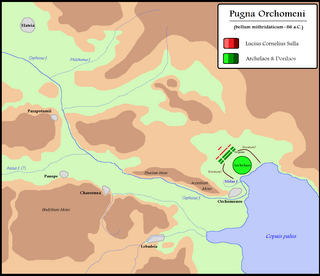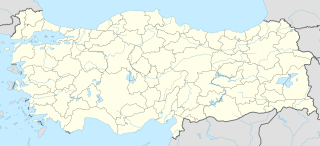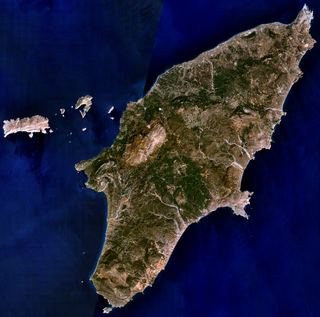 W
WThe Mithridatic Wars were three conflicts fought by Rome against the Kingdom of Pontus and its allies between 88 BC and 63 BC. They are named after Mithridates VI, the King of Pontus who initiated the hostilities after annexing the Roman province of Asia into its Pontic Empire and committing massacres against the local Roman population known as the Asian Vespers. As Roman troops were sent to recover the territory, they faced an uprising in Greece organized and supported by Mithridates. Mithridates was able to mastermind such general revolts against Rome and played the magistrates of the optimates party off against the magistrates of the populares party in the Roman civil wars. Nevertheless, the first war ended with a Roman victory, confirmed by the Treaty of Dardanos signed by Lucius Sulla and Mithridates. Greece was restored to Roman rule and Pontus was expected to restore the status quo ante bellum in Asia Minor.
 W
WThe First Mithridatic War was a war challenging the Roman Republic's expanding empire and rule over the Greek world. In this conflict, the Kingdom of Pontus and many Greek cities rebelling against Roman rule were led by Mithridates VI of Pontus against Rome and the allied Kingdom of Bithynia. The war lasted five years and ended in a Roman victory which forced Mithridates to abandon all of his conquests and return to Pontus. The conflict with Mithridates VI later resumed in two further Mithridatic Wars.
 W
WThe Battle of the Abas was fought in 65 BC between the forces of the Roman Republic under Pompey Magnus and those of the Caucasian Albanian King Oroeses during the course of the Third Mithridatic War. The battle took place on a flat plain by the River Abas, after the Roman forces had only recently crossed over it from the other bank, and with much dense forest nearby. Pompey's victory neutralised the threat of the Albanians rejoining with their old ally Mithridates in his attempts to rekindle his lost war with Rome.
 W
WAristarchus was a ruler of Colchis as a client of Rome from 63 BC to c. 50 BC. He was installed by the Roman general Pompey as part of his settlement of Asia during the Mithridatic Wars. Aristarchus is principally known from the works of the 1st-century historian Appian as well as the coinage issued in his name.
 W
WThe Asiatic Vespers refers to the genocide of Roman and other Latin-speaking peoples living in parts of western Anatolia in 88 BC by forces loyal to Mithridates VI Eupator, ruler of the Kingdom of Pontus, who orchestrated the massacre in an attempt to rid Asia Minor of Roman influence. An estimated 80,000 people were killed during the episode, which is considered one of the deadliest recorded genocides in Classical antiquity. The incident served as the casus belli or immediate cause of the First Mithridatic War between the Roman Republic and the Kingdom of Pontus.
 W
WThe Battle of Protopachium was fought in 89 BC at the start of the First Mithridatic War, between the Roman Republic and the Pontic Empire. The battle ended in a Roman defeat and their expulsion from Asia Minor.
 W
WThe Battle of Cabira was fought in 72 or 71 BC between forces of the Roman Republic under proconsul Lucius Licinius Lucullus and those of the Kingdom of Pontus under Mithridates the Great. It was a decisive Roman victory.
 W
WThe Battle of Chaeronea was fought by the Roman forces of Lucius Cornelius Sulla and Mithridates' general, Archelaus, near Chaeronea, in Boeotia, in 86 BC during the First Mithridatic War. The battle ended with a complete rout of the Pontic army and a decisive victory for the Romans.
 W
WThe Battle of Chalcedon was a land and naval battle between the Roman Republic and king Mithridates VI of Pontus near the city of Chalcedon in 74 BC. The battle was the first major clash of the Third Mithridatic War. The Roman forces were led by Marcus Aurelius Cotta, one of the consuls for 74 BC, while Mithridates had the overall command of the Pontic forces. The Mithridatic forces were victorious on both land and sea.
 W
WDrypetina, Dripetrua was a devoted daughter of King Mithridates VI of Pontus and his sister-wife Laodice. Her name is the diminutive form of the name of Drypetis, daughter of the Achaemenid king Darius III. She had a double row of teeth. According to Ammianus Marcellinus, during the Third Mithridatic War, Drypetina, severely ill, was left behind in the fortress of Sinora under the protection of the eunuch Menophilus. When the Roman forces under Mallius Priscus besieged the fortress, Menophilus killed the princess to prevent her from being captured by the Romans and then committed suicide. She appears in De Mulieribus Claris by Giovanni Boccaccio as "Dripetrua, queen of Laodicea".
 W
WMithridates or Mithradates VI Eupator was ruler of the Hellenistic Kingdom of Pontus in northern Anatolia from 120 to 63 BC, and one of the Roman Republic's most formidable and determined opponents. He was an effective, ambitious and ruthless ruler who sought to dominate Asia Minor and the Black Sea region, waging several hard-fought but ultimately unsuccessful wars to break Roman dominion over Asia and the Hellenic world. He has been called the greatest ruler of the Kingdom of Pontus. After his death he became known as Mithridates the Great; due to his affinity for poison he has also been called "The Poison King".
 W
WThe Battle of Orchomenus was fought in 85 BC between Rome and the forces of Mithridates VI of Pontus. The Roman army was led by Lucius Cornelius Sulla, while Mithridates' army was led by Archelaus. The Roman force was victorious, and Archelaus later defected to Rome. The battle ended the Mithridatic invasion of Europe. Information on the battle is included in Plutarch's Life of Sulla, chapters 20–21.
 W
WRoman command structure during First Mithridatic War refers to the chain of command of the forces sent east by the government of Rome to exercise the Mithridatic War mandate, requiring those forces to defeat Mithridates VI of Pontus, who had evoked the ire of the Senatus Populusque Romanus (SPQR) by slaughtering all the Romans his adherents could find on a single, pre-arranged day, an event now termed the Asiatic Vespers. Previously in Roman history the war and the command structure would have been straightforward: the Senate would declare war, and the mandate to carry it out would be assigned to one of the two consuls elected for the year, with both being assigned if necessary, and ex-consuls being available as generals with the rank of proconsul. For a small war the consul might give the task to an immediate subordinate, a praetor, or if the task was small enough, a legate.
 W
WThe Second Mithridatic War was one of three wars fought between Pontus and the Roman Republic. This war was fought between King Mithridates VI of Pontus and the Roman general Lucius Licinius Murena.
 W
WThe Siege of Athens and Piraeus was a siege of the First Mithridatic War that took place from Autumn of 87 BC to the Spring and Summer of 86 BC. The battle was fought between the forces of the Roman Republic, commanded by Lucius Cornelius Sulla Felix on the one hand, and the forces of the Kingdom of Pontus and the Athenian City-State on the other. The Greek Pontian forces were commanded by Aristion and Archelaus.
 W
WThe siege of Cyzicus took place in 73 BC between the armies of Mithridates VI of Pontus and the Roman-allied citizens of Cyzicus in Mysia and Roman Republican forces under Lucius Licinius Lucullus. It was in fact a siege and a counter-siege. It ended in a decisive Roman victory.
 W
WThe Siege of Heraclea was a military investment of the city of Heraclea Pontica during the Third Mithridatic War. The siege was conducted by the Roman proconsul Marcus Aurelius Cotta and the legate Gaius Valerius Triarius. They were besieging the adherents of Mithridates of Pontus, who held the city for the Pontic king. Heraclea was located on the strategically important northern land route into the kingdom of Pontus and had been taken and garrisoned by Mithridates on his retreat from the Siege of Cyzicus. The 4,000-man strong Mithridatic garrisoned was commanded by Connacorex, one of the king's generals, and held out for almost two years. After taking Heraclea, the Romans plundered the city extensively.
 W
WThe siege of Rhodes took place in 88 BC between the people of Rhodes and Mithridates VI of Pontus' army. The Rhodian forces were led by an admiral called Demagoras and the proconsul of Asia, Lucius Cassius, with them. After the defeat of Rome in the Battle of Protopachium, Rome was forced to retreat from Asia and the only major independent power left in that province was Rhodes. Rhodes had previously been an ally to both Mithridates and Rome, but now it only preferred Rome.
 W
WThe Battle of the River Amnias was a battle fought in 89 BC between Mithradates VI of Pontus and Nicomedes IV of Bithynia during the First Mithridatic War. The forces of Pontus were commanded by Archelaus and Neoptolemus, while the Bithynians were led by King Nicomedes himself. Pontus was victorious. This battle and subsequent events would lead to the loss of Roman rule in the province of Asia for some years.
 W
WThe Third Mithridatic War, the last and longest of the three Mithridatic Wars, was fought between Mithridates VI of Pontus and the Roman Republic. Both sides were joined by a great number of allies dragging the entire east of the Mediterranean and large parts of Asia into the war. The conflict ended in defeat for Mithridates, ending the Pontic Kingdom, ending the Seleucid Empire, and also resulting in the Kingdom of Armenia becoming an allied client state of Rome.
 W
WThe Battle of Tigranocerta was fought on 6 October 69 BC between the forces of the Roman Republic and the army of the Kingdom of Armenia led by King Tigranes the Great. The Roman force, led by Consul Lucius Licinius Lucullus, defeated Tigranes, and as a result, captured Tigranes' capital city of Tigranocerta.